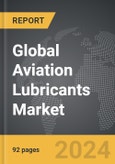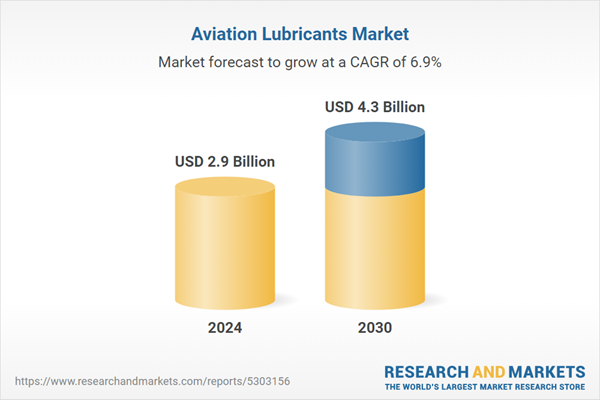The global market for Aviation Lubricants was valued at US$2.9 Billion in 2024 and is projected to reach US$4.3 Billion by 2030, growing at a CAGR of 6.9% from 2024 to 2030. This comprehensive report provides an in-depth analysis of market trends, drivers, and forecasts, helping you make informed business decisions. The report includes the most recent global tariff developments and how they impact the Aviation Lubricants market.
Segments: Type (Engine Oil, Hydraulic Fluid, Grease, Special Lubricants & Additives); Platform (Commercial Aviation, Business & General Aviation, Military Aviation); Technology (Mineral-based, Synthetic); Application (Engine, Hydraulic Systems, Landing Gear, Airframe, Other Applications).
Geographic Regions/Countries: World; United States; Canada; Japan; China; Europe (France; Germany; Italy; United Kingdom; Spain; Russia; and Rest of Europe); Asia-Pacific (Australia; India; South Korea; and Rest of Asia-Pacific); Latin America (Argentina; Brazil; Mexico; and Rest of Latin America); Middle East (Iran; Israel; Saudi Arabia; United Arab Emirates; and Rest of Middle East); and Africa.
The analysts continuously track trade developments worldwide, drawing insights from leading global economists and over 200 industry and policy institutions, including think tanks, trade organizations, and national economic advisory bodies. This intelligence is integrated into forecasting models to provide timely, data-driven analysis of emerging risks and opportunities.
Global Aviation Lubricants Market - Key Trends and Drivers Summarized
Why Are Aviation Lubricants Critical in Aircraft Performance?
In the demanding world of aviation, lubricants are not just a mechanical necessity - they are essential for the reliable, efficient, and safe operation of aircraft. Aviation lubricants perform under highly challenging conditions, where engines and components are exposed to extreme temperatures, high pressures, and constant friction. These specialized lubricants minimize wear, reduce friction, and protect vital components against corrosion, which ensures smooth operations and extends the life of aircraft parts. Unlike conventional lubricants, aviation-grade variants are specifically formulated to maintain a stable viscosity across a wide range of temperatures, preventing issues such as overheating and mechanical failure, even when subjected to rapid environmental changes, like takeoff and landing. From high-performance turbine oils used in jet engines to hydraulic fluids ensuring responsive control surfaces and greases applied to various moving parts, each lubricant type is tailored to meet rigorous aviation standards. By reducing energy losses due to friction, these lubricants also contribute to improved fuel efficiency, which is critical as airlines strive to lower operational costs and meet emissions targets. Consequently, aviation lubricants have become indispensable to the industry, supporting everything from daily performance reliability to the operational longevity of aircraft fleets.How Do Aviation Lubricants Contribute to Safety and Compliance?
The aviation industry operates within one of the most heavily regulated frameworks worldwide, prioritizing safety and compliance at every operational level. Aviation lubricants play a crucial role in supporting this regulatory framework, as they ensure optimal performance while adhering to stringent safety and quality standards set by aviation authorities like the Federal Aviation Administration (FAA), the European Union Aviation Safety Agency (EASA), and other regulatory bodies. These standards address essential characteristics such as thermal stability, anti-wear properties, material compatibility, and flash points, making sure that lubricants perform reliably under extreme conditions. For instance, turbine oils used in aircraft engines must have exceptional oxidative stability to prevent the formation of deposits that could reduce engine efficiency or even lead to mechanical failures mid-flight. Additionally, maintenance protocols in aviation demand meticulous record-keeping, which includes tracking lubricant type, quantity, and application to each component. These records are essential for passing regulatory audits and proving compliance, as they document that the aircraft's maintenance meets safety standards. By providing high-performance lubricants that are reliable, tested, and compliant with aviation regulations, manufacturers contribute significantly to the overall safety ecosystem of air travel. Aviation lubricants thus not only ensure mechanical efficiency but also reinforce the industry’s commitment to safe and regulated operations, safeguarding both passengers and crew.What Role Do Aviation Lubricants Play in Sustainability and Innovation?
Sustainability has become a pressing issue in the aviation industry, and aviation lubricants are adapting to align with new environmental and efficiency goals. There is an increasing demand for eco-friendly, biodegradable lubricants that reduce the environmental impact of aviation operations. New formulations are emerging that offer lower emissions profiles and enhanced energy efficiency, addressing the industry’s push to reduce its carbon footprint. By decreasing friction within engines and mechanical systems, these lubricants contribute to more efficient fuel consumption, directly supporting airline efforts to lower emissions. Furthermore, synthetic lubricants have become popular in aviation, offering superior thermal stability, lower volatility, and extended operational lifespans compared to traditional mineral-based lubricants. This extended lifespan is not only economical but also environmentally beneficial, as it reduces waste generated from lubricant disposal and limits the frequency of lubricant changes, thereby decreasing resource consumption. Innovation is also seen with nano-additive technology, where nanoparticles are incorporated into lubricants to significantly enhance friction-reducing capabilities, making engines run smoother and conserving more fuel. As aviation moves towards hybrid and electric propulsion technologies, the need for specially formulated lubricants tailored to these advanced systems is growing. These innovations signify a shift in the aviation lubricant market, as sustainability and performance become inextricably linked in the development of future lubricant products.What Factors Are Driving Growth in the Aviation Lubricants Market?
The growth in the aviation lubricants market is driven by several factors, each connected to technological advancements, regulatory requirements, and evolving industry priorities. As air travel demand continues to rise globally, fleet expansions across commercial, cargo, and military aviation sectors have led to higher lubricant consumption, especially given the rigorous maintenance schedules that modern aviation demands. With more frequent flights and a growing number of aircraft in service, the demand for specialized, high-performance lubricants has surged. Regulatory bodies worldwide are also enforcing stricter environmental standards, encouraging the adoption of eco-friendly lubricants that meet emissions requirements while providing longer service intervals, which helps reduce both operational costs and environmental impact. Preventative and predictive maintenance practices have gained prominence, making high-quality lubricants an integral component of proactive asset management strategies that prevent unplanned downtime and enhance equipment reliability. Additionally, the aviation industry’s pivot towards sustainable practices, including hybrid and electric propulsion, has fostered demand for innovative lubricants that meet the specific requirements of these new technologies. Emerging aviation segments, such as unmanned aerial vehicles (UAVs) and urban air mobility solutions, are expanding the market further, as each type of aircraft requires tailored lubricants suited to its unique operational needs. Altogether, these factors underline a robust growth trajectory for the aviation lubricants market, as it adapts to the industry’s demands for efficiency, safety, and sustainability.Report Scope
The report analyzes the Aviation Lubricants market, presented in terms of units. The analysis covers the key segments and geographic regions outlined below.Segments: Type (Engine Oil, Hydraulic Fluid, Grease, Special Lubricants & Additives); Platform (Commercial Aviation, Business & General Aviation, Military Aviation); Technology (Mineral-based, Synthetic); Application (Engine, Hydraulic Systems, Landing Gear, Airframe, Other Applications).
Geographic Regions/Countries: World; United States; Canada; Japan; China; Europe (France; Germany; Italy; United Kingdom; Spain; Russia; and Rest of Europe); Asia-Pacific (Australia; India; South Korea; and Rest of Asia-Pacific); Latin America (Argentina; Brazil; Mexico; and Rest of Latin America); Middle East (Iran; Israel; Saudi Arabia; United Arab Emirates; and Rest of Middle East); and Africa.
Key Insights:
- Market Growth: Understand the significant growth trajectory of the Engine Oil segment, which is expected to reach US$2.0 Billion by 2030 with a CAGR of a 6.6%. The Hydraulic Fluid segment is also set to grow at 7.7% CAGR over the analysis period.
- Regional Analysis: Gain insights into the U.S. market, valued at $756.0 Million in 2024, and China, forecasted to grow at an impressive 10.1% CAGR to reach $1.0 Billion by 2030. Discover growth trends in other key regions, including Japan, Canada, Germany, and the Asia-Pacific.
Why You Should Buy This Report:
- Detailed Market Analysis: Access a thorough analysis of the Global Aviation Lubricants Market, covering all major geographic regions and market segments.
- Competitive Insights: Get an overview of the competitive landscape, including the market presence of major players across different geographies.
- Future Trends and Drivers: Understand the key trends and drivers shaping the future of the Global Aviation Lubricants Market.
- Actionable Insights: Benefit from actionable insights that can help you identify new revenue opportunities and make strategic business decisions.
Key Questions Answered:
- How is the Global Aviation Lubricants Market expected to evolve by 2030?
- What are the main drivers and restraints affecting the market?
- Which market segments will grow the most over the forecast period?
- How will market shares for different regions and segments change by 2030?
- Who are the leading players in the market, and what are their prospects?
Report Features:
- Comprehensive Market Data: Independent analysis of annual sales and market forecasts in US$ Million from 2024 to 2030.
- In-Depth Regional Analysis: Detailed insights into key markets, including the U.S., China, Japan, Canada, Europe, Asia-Pacific, Latin America, Middle East, and Africa.
- Company Profiles: Coverage of players such as Aerospace Lubricants, Inc., BP, Candan Industries, Eastman Chemical Company, Everlube Products and more.
- Complimentary Updates: Receive free report updates for one year to keep you informed of the latest market developments.
Some of the 36 companies featured in this Aviation Lubricants market report include:
- Aerospace Lubricants, Inc.
- BP
- Candan Industries
- Eastman Chemical Company
- Everlube Products
- Exxonmobil
- Fuchs
- Jet-Lube
- Lanxess
- Lukoil
Tariff Impact Analysis: Key Insights for 2025
Global tariff negotiations across 180+ countries are reshaping supply chains, costs, and competitiveness. This report reflects the latest developments as of April 2025 and incorporates forward-looking insights into the market outlook.The analysts continuously track trade developments worldwide, drawing insights from leading global economists and over 200 industry and policy institutions, including think tanks, trade organizations, and national economic advisory bodies. This intelligence is integrated into forecasting models to provide timely, data-driven analysis of emerging risks and opportunities.
What’s Included in This Edition:
- Tariff-adjusted market forecasts by region and segment
- Analysis of cost and supply chain implications by sourcing and trade exposure
- Strategic insights into geographic shifts
Buyers receive a free July 2025 update with:
- Finalized tariff impacts and new trade agreement effects
- Updated projections reflecting global sourcing and cost shifts
- Expanded country-specific coverage across the industry
Table of Contents
I. METHODOLOGYII. EXECUTIVE SUMMARY2. FOCUS ON SELECT PLAYERSIII. MARKET ANALYSISCANADAITALYSPAINRUSSIAREST OF EUROPESOUTH KOREAREST OF ASIA-PACIFICARGENTINABRAZILMEXICOREST OF LATIN AMERICAIRANISRAELSAUDI ARABIAUNITED ARAB EMIRATESREST OF MIDDLE EASTIV. COMPETITION
1. MARKET OVERVIEW
3. MARKET TRENDS & DRIVERS
4. GLOBAL MARKET PERSPECTIVE
UNITED STATES
JAPAN
CHINA
EUROPE
FRANCE
GERMANY
UNITED KINGDOM
ASIA-PACIFIC
AUSTRALIA
INDIA
LATIN AMERICA
MIDDLE EAST
AFRICA
Companies Mentioned (Partial List)
A selection of companies mentioned in this report includes, but is not limited to:
- Aerospace Lubricants, Inc.
- BP
- Candan Industries
- Eastman Chemical Company
- Everlube Products
- Exxonmobil
- Fuchs
- Jet-Lube
- Lanxess
- Lukoil
Table Information
| Report Attribute | Details |
|---|---|
| No. of Pages | 92 |
| Published | April 2025 |
| Forecast Period | 2024 - 2030 |
| Estimated Market Value ( USD | $ 2.9 Billion |
| Forecasted Market Value ( USD | $ 4.3 Billion |
| Compound Annual Growth Rate | 6.9% |
| Regions Covered | Global |









